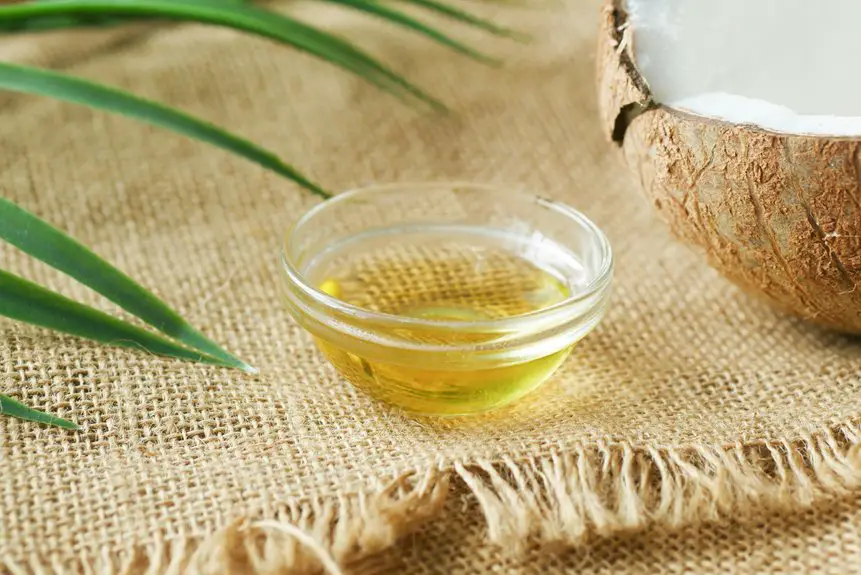To get coconut oil out of fabric, start by blotting excess oil and applying dish soap, then soak it in hot water for 15 minutes. You can also sprinkle baking soda or cornstarch to absorb grease before brushing it off. Try spraying white vinegar mixture or rubbing lemon juice with salt onto the stain. Finally, wash the fabric in warm water with laundry detergent. These simple steps can make a big difference, and you’ll find more tips to tackle tough stains easily.
Table of Contents
Key Takeaways
- Blot excess coconut oil gently, apply dish soap, soak in hot water, then rub and rinse thoroughly.
- Sprinkle baking soda or cornstarch on stain, let sit 15-30 minutes, brush off, and repeat if needed.
- Spray equal parts white vinegar and warm water on stain, soak 10-15 minutes, blot, then rinse with cold water.
- Cover stain with salt, add lemon juice, let sit 15-20 minutes, rub gently, and rinse with cold water.
- Pre-soak fabric in warm water with laundry detergent for 15-30 minutes, agitate gently, then rinse using warm water.
Using Dish Soap and Hot Water
Although coconut oil can be stubborn, you can effectively remove it from fabric by using dish soap and hot water.
Start by blotting the excess oil gently with a paper towel—don’t rub, or you’ll spread it further. Next, apply a few drops of dish soap directly onto the stain. Dish soap is designed to cut through grease, making it ideal for this job.
Then, soak the fabric in hot water, ensuring the water temperature is safe for the fabric type. Let it sit for about 15 minutes to break down the oil. After soaking, gently rub the stained area to lift the oil.
Finally, rinse thoroughly and check if the stain has disappeared before drying. Repeat if necessary, but avoid drying until the stain is gone.
Applying Baking Soda or Cornstarch
When coconut oil leaves a stain on your fabric, applying baking soda or cornstarch can help absorb the excess grease quickly.
Sprinkle a generous amount of baking soda or cornstarch directly onto the oily stain. Let it sit for at least 15 to 30 minutes—longer if the stain is fresh or large. These powders draw out the oil without spreading it further.
After the waiting period, gently brush off the powder with a soft brush or cloth. You’ll notice the stain looks lighter as the baking soda or cornstarch lifts the grease.
Repeat this process if necessary before washing. This simple step helps prevent the oil from setting deeper into the fibers, making your fabric easier to clean in the next stages.
Treating With White Vinegar
Since coconut oil stains are stubborn, treating the fabric with white vinegar can break down the grease effectively. You’ll want to dilute white vinegar with water to avoid damaging the fabric.
Here’s how to do it:
- Mix equal parts white vinegar and warm water in a spray bottle.
- Spray the stained area generously, letting the solution soak in for 10-15 minutes.
- Gently blot the fabric with a clean cloth to lift the stain without spreading it.
Afterward, rinse the fabric with cold water and launder it as usual.
Vinegar’s natural acidity cuts through oil, making it easier to remove stubborn coconut oil spots. Just be certain to test it on a hidden area first to guarantee it won’t affect the color or texture of your fabric.
Utilizing Lemon Juice and Salt
If you want to tackle coconut oil stains naturally, lemon juice and salt make a powerful duo.
First, sprinkle salt generously over the stained area to absorb excess oil. Then, squeeze fresh lemon juice directly onto the salt-covered spot. The lemon’s acidity helps break down the oil, while the salt acts as a gentle abrasive.
Let this mixture sit for about 15 to 20 minutes, but don’t let it dry completely to avoid fabric damage. Afterward, gently rub the fabric together or use a soft brush to lift the stain.
Finally, rinse the fabric with cold water to remove the residue. This method works well on fresh stains and is a great natural alternative to harsh chemicals.
Washing With Laundry Detergent and Warm Water
After treating the stain with lemon juice and salt, you’ll want to follow up with a thorough wash using laundry detergent and warm water. This step helps break down the coconut oil residue and lifts it from the fabric fibers.
Use the warmest water temperature safe for your fabric, as indicated on its care label, to enhance detergent effectiveness.
When washing, keep these tips in mind:
- Pre-soak the fabric in warm water mixed with detergent for 15-30 minutes.
- Gently agitate the fabric to loosen the oil without damaging it.
- Rinse thoroughly to remove both detergent and loosened oil particles.
Completing this step properly greatly improves your chances of removing the coconut oil stain completely.
Frequently Asked Questions
Can Coconut Oil Stains Be Removed From Delicate Fabrics Like Silk?
You can remove coconut oil stains from delicate fabrics like silk, but you should act quickly. Use a gentle detergent and cold water, avoid harsh scrubbing, and consider professional cleaning if the stain persists to protect the fabric.
How Soon Should I Treat Coconut Oil Stains for Best Results?
You’ll want to tackle those unexpected marks before they settle in for a permanent stay. Treat coconut oil stains as soon as you spot them—acting quickly boosts your chances of a spotless, fresh finish every time.
Are There Any Commercial Stain Removers Specifically for Coconut Oil?
You’ll find most commercial stain removers don’t target coconut oil specifically, but enzyme-based or grease-fighting formulas work well. Try brands like OxiClean or Shout—they’re designed to break down oils effectively on fabric.
Will Coconut Oil Stains Cause Permanent Discoloration if Untreated?
If you don’t treat coconut oil stains promptly, they can cause permanent discoloration on your fabric. Acting quickly helps prevent the oil from setting, so you won’t have to worry about stubborn, lasting marks.
Can I Use a Dryer Immediately After Removing Coconut Oil Stains?
Don’t count your chickens before they hatch—dryers can set coconut oil stains if they’re not fully gone. You should air-dry the fabric after treating it, then only use the dryer once the stain’s completely removed.
- What Is Gor-Tex? a Common Misspelling Explained - July 2, 2025
- Is Gore-Tex Worth It for Skiing and Snowboarding? - July 2, 2025
- How to Apply a Gore-Tex Patch for a Perfect Repair - July 2, 2025






